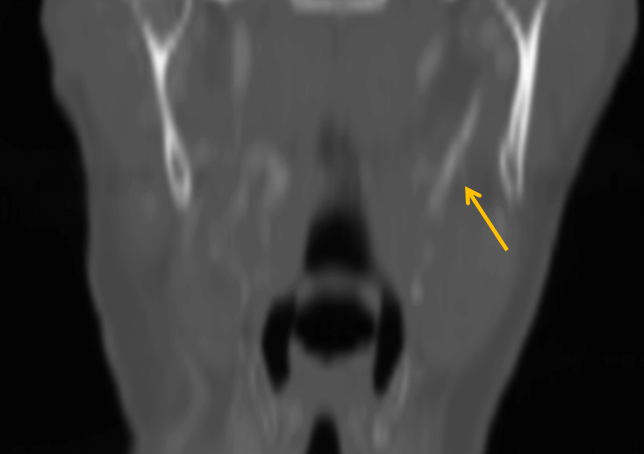One-sided throat discomfort with dysphagia – what’s the diagnosis?

A 69-year-old lady reported a 30-year history of left-sided throat discomfort and a six-month history of dysphagia. She was eating a normal diet, however, and denied that she was losing weight. She had undergone tonsillectomy in childhood for recurrent tonsillitis. She had recently been reviewed by an ENT consultant locally and reassured nothing abnormal could be found. She was an ex-smoker and drank minimal alcohol.
She was referred to clinic and examination of her neck revealed tenderness and fullness in the left neck just below the submandibular area. Mouth examination revealed a palpable projection in the inferior tonsillar fossa. Flexible nasal endoscopy showed a normal larynx and pharynx. A CT neck scan demonstrated a 45mm left-sided styloid process, with a 25mm styloid process on the right side. The styloid process was removed uneventfully using a transoral approach, with immediate resolution of her symptoms.
Background
Eagle’s syndrome is a rare disease caused by elongation of the styloid process or calcification of the stylohyoid ligament. It was first described by US ear, nose and throat surgeon Watt Eagle in 1937 with a series of 200 patients.1 The styloid process projects from the tympanic part of the temporal bone and attaches to several muscles and ligaments associated with the tongue and larynx. Its tip lies between the external and internal carotid arteries. It normally measures around 3cm, and is considered to be pathologically elongated if it exceeds this length. Elongation is estimated to be present in 4% of the adult population, but only a small fraction of these are symptomatic.2
The condition is more common in women, with a 3:1 female-to-male ratio. Angulation of the styloid process may also be important in rendering patients with elongated styloid processes symptomatic. The diagnosis is made with the identification of an elongated styloid process, usually through imaging, characteristic symptoms and exacerbation of pain on palpation of the tonsil. The most typical symptom is unilateral throat pain or foreign body sensation. Consequently, it is important to exclude a head and neck malignancy in patients with these lateralised throat symptoms. Other symptoms include dysphagia, pain on head rotation, otalgia, dizziness and headaches.
Eagle’s syndrome can be a unilateral or bilateral phenomenon, with the cause of the elongation of the styloid process poorly understood.3 There are three main theories:
- Congenital – due to persistence of one of the embryological precursors of the styloid.
- Idiopathic calcification of the styloid ligament.
- Osseous tissue outgrowth at the insertion of the styloid ligament.
The cause of the symptoms resulting from the elongation of the styloid is also unclear, with a number of mechanisms suggested:
- Traumatic – fracture of the styloid process causing granulation tissue exerting a local mass effect.
- Neurological – due to compression of the glossopharyngeal, trigeminal or chorda tympani nerves.
- Inflammatory – tendonitis at the stylohyoid insertion.
- Direct mucosal irritation.
- Impingement of the carotid vessels, causing sympathetic nerve stimulation.3
Investigations
It is of paramount importance to exclude a pharyngeal or laryngeal malignancy in patients with unilateral throat symptoms with or without dysphagia, especially in patients over 40 years of age and with a smoking or excess alcohol consumption history. Perform a full ENT examination, with careful inspection of the larynx and pharynx. Palpation of the tonsil fossa often reveals a bony projection and causes discomfort. Some specialists report that infiltration of the tonsillar fossa with local anaesthetic can result in relief of symptoms but the best way to confirm the diagnosis is with imaging (nasal endoscopy with careful inspection of the larynx and pharynx can be done in secondary care). Orthopantomogram or CT are often used but the latter is more useful in accurately gauging the length of the styloid process and its relation to surrounding structures. CT with contrast is helpful to determine the vascular relations, as the process typically passes between the internal and carotid arteries.

Figure 1 – a coronal CT neck with contrast. The arrow indicates the elongated styloid process.
Differential diagnosis
A malignant cause of unilateral throat pain and dysphagia should be urgently excluded via a two-week wait suspected cancer referral. Some of the symptoms of Eagle’s syndrome can be non-specific and differentials include dental problems (malocclusion and temporomandibular joint pathology), glossopharyngeal or trigeminal neuralgia, recurrent tonsillitis or pharyngitis and arthritis of cervical vertebrae. Patients often bounce between GPs, dentists, neurologists, neurosurgeons, psychiatrists and ENT surgeons.
Treatment
Eagle’s syndrome can be treated conservatively, medically or surgically. Some patients have minor symptoms and are happy to live with the condition when they are reassured the cause has been accurately determined. NSAIDs and steroid injections can be helpful in some selected patients but the majority of patients are treated surgically via a transoral or transcervical approach.
The transoral approach is a quick day-case procedure with a short recovery time. There are no external incisions and the risk of neurovascular injury is small. The procedure starts with an access tonsillectomy and the elongated styloid process is identified in the tonsillar fossa. The periosteum of the process is incised and the bone exposed. The process is then followed superiorly and then excised with bone cutting shears. The pharyngeal mucosa is sutured closed.
The transcervical approach is usually more involved, entailing an overnight hospital stay. It is done by an external skin crease neck incision, splitting of the digastric muscle, resection of the styloid process and placement of a surgical drain. Recovery time is longer and there is a higher risk of neurovascular injury. A rare condition called ‘first bite syndrome’ can result from this and other parapharyngeal space surgery. It is characterised by facial or mandibular pain after the first bite of each meal and is thought to be caused by autonomic dysfunction.
Mr Jonathan Hughes is a consultant ENT, thyroid and head and neck surgeon at University College London Hospitals and Royal Free London NHS Foundation Trusts.
Conflicts: none declared
References
- Eagle W. Elongated styloid process. Arch Otolaryngol 1937;25 :584-7
- Mortellaro C, Biancucci P, Picciolo G et al. Eagle’s syndrome: importance of a corrected diagnosis and adequate surgical treatment. J Craniofac Surg 2002;13:755-8
- Mendelsohn A, Berke G, Chhetri D. Heterogeneity in the clinical presentation of Eagle’s syndrome. Otolaryngol Head Neck Surg 2006;134:389-93
Portfolio careers
What is the right portfolio career for you?

Visit Pulse Reference for details on 140 symptoms, including easily searchable symptoms and categories, offering you a free platform to check symptoms and receive potential diagnoses during consultations.














